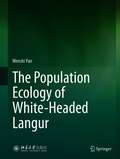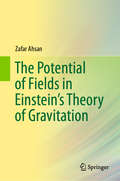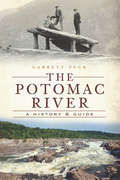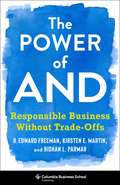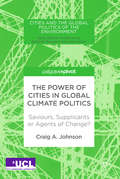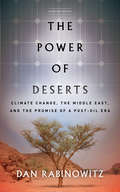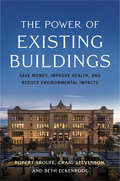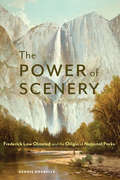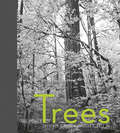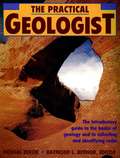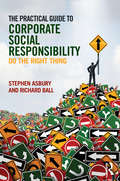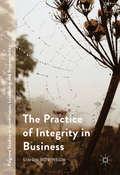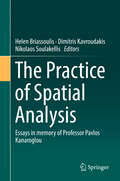- Table View
- List View
The Pond in the Park: Where Frogs and Friendships Grow (Woke Babies Books)
by Flo FieldingA magical STEM story that sees frog spawn transform into frogs as Millie’s own special friendship grows.Millie has started at a new school and making friends hasn’t been easy. On a morning stroll through the park before school, Millie’s dad points out a pond filled with frog spawn and explains that soon they will go through BIG changes. Just as the frog spawn will grow and transform, can Millie embrace the changes in her life?Made in collaboration with Woke Babies, this book offers a gentle introduction to the incredible life cycle of a frog, while helping children overcome their own worries about change and new beginnings. This is a wonderful reminder that sometimes friendships take time to blossom, but it encourages children to take a chance anyway. With vivid illustrations accompanying the exciting STEM story, The Pond in the Park is the perfect gift for a little one, or for anyone looking for a heart-warming story with inspiring characters.
The Population Ecology and Conservation of Charadrius Plovers (Studies in Avian Biology #53)
by Mark A. Colwell Susan M. HaigThe 40 or so species of beach-loving plovers (genus Charadrius) comprise a diverse group of shorebirds found around the world. Most of these species are challenged by changing climates and other human-related development activities, yet they provide key insights into basic ecological and evolutionary processes. The expert international contributors take a comparative approach, presenting examples from many worldwide plover studies and synthesizing the group’s most pressing and important topics. The book further presents an emphasis on full life-cycle biology, including the importance of examining migratory connectivity issues, even for non-migratory plovers. Key Features Serves as a fundamental resource for conservation practitioners Detailed overview of a widely distributed group of shorebirds Authored by renowned specialists who present theoretical and applied perspectives Emphasis on comparative and synthetic approach in all chapters Related Titles McComb, B. et al. Monitoring Animal Populations and Their Habitats: A Practitioner’s Guide (ISBN 978-0-4291-3827-0). Garvey, J. E. & M. R. Whiles. Trophic Ecology (ISBN 978-1-4987-5846-8). Dewdney, A. K. Stochastic Communities: A Mathematical Theory of Biodiversity (ISBN 978-1-1381-9702-2).
The Population Ecology of White-Headed Langur
by Wenshi PanThis book offers a rare and detailed insight into 20 years’ of in-depth field research and conservation of the white-headed langur. It focuses on the white-headed langur’s natural refuge, territory and home range, diets and foraging strategies, behavior modes, reproductive strategies, population, possible future viabilities, and their interaction with human society. From 1996 through 2016, a small research team led by Prof.Wenshi Pan from Peking University conducted studies and conservation efforts on the white-headed langur, one of the most endangered endemic species of China, in Guangxi and saved the species from extinction. With the help of conservationists’ efforts, the white-headed langur population in Nongguan Mountains, Guangxi, gradually increased from 105 to approximately 820.This book shares the success story of the unification of human development and wildlife conservation.
The Positive Impact Mindset: Working Together in a Polarized World
by Katrin MuffWe are facing a new and urgent challenge when collaborating across organizations, and with broader stakeholder groups: how to overcome polarization. It has never been harder to find a common vision, when opinions are often considered as facts. This book empowers changemakers and business leaders to understand how successful organizations in the 21st century require leaders to become fluent in collaborating outside of traditional business boundaries. Such collaboration often involves working with parties that hold very different values, opinions and priorities, and working with them requires new skills. Building on the book Five Superpowers for Co-Creators, Katrin Muff presents a number of real-world examples that demonstrate how organizations have successfully managed to address these challenges. Examples of such unlikely but successful cross-sector collaboration include a project addressing plastic waste in Switzerland, and two European city government projects that reached out beyond organizational boundaries. The book features many stories of trial and error in overcoming the societal polarization gap. From all these insights emerges clear guidance as to how leaders and organizations can transform to new ‘outside-in’ mindsets to overcome polarization and develop a Positive Impact Mindset. The book is ideal for use by facilitators, educators, business and political leaders, and consultants, who are seeking solutions within an often polarized world to achieve sustainable change and a positive impact.
The Post-Earthquake City: Disaster and Recovery in Christchurch, New Zealand (Routledge Studies in Hazards, Disaster Risk and Climate Change)
by Paul Cloke David Conradson Eric Pawson Harvey C. PerkinsThis book critically assesses Christchurch, New Zealand as an evolving post-earthquake city. It examines the impact of the 2010–13 Canterbury earthquake sequence, employing a chronological structure to consider ‘damage and displacement’, ‘recovery and renewal’ and ‘the city in transition’. It offers a framework for understanding the multiple experiences and realities of post-earthquake recovery. It details how the rebuilding of the city has occurred and examines what has arisen in the context of an unprecedented opportunity to refashion land uses and social experience from the ground up. A recurring tension is observed between the desire and tendency of some to reproduce previous urban orthodoxies and the experimental efforts of others to fashion new cultures of progressive place-making and attention to the more-than-human city. The book offers several lessons for understanding disaster recovery in cities. It illuminates the opportunities disasters create for both the reassertion of the familiar and the emergence of the new; highlights the divergence of lived experience during recovery; and considers the extent to which a post-disaster city is prepared for likely climate futures. The book will be valuable reading for critical disaster researchers as well as geographers, sociologists, urban planners and policy makers interested in disaster recovery.
The Post-Soviet States: Mapping the Politics of Transition
by Graham SmithThe collapse of the Soviet Union has engendered one of the most momentous and critical regional transformations of our tiomes through the formation and development of the post-Soviet states. This book explores the politics of post-Soviet transition and the problems which will continue to face these states well into the twenty-first century, as they struggle towards democracy, market reform, ethnic co-existance and integration into a new geoplolitical post-Cold War world order.Richly illustrated with examples drawn from Russian and other post-Soviet primary sources, the author focuses on three broad themes of transition. Firstly, the progression from colonialism to post-colonialism and the consquences of such changes on national identity and the redefinition of national homeland. Secondly, the movement away from totalitarian rule and the factors which both facilitate and challenge the prospects of a democratic future. Thirdly, the process of securing a successful place in the global capitalist economy.
The Potential of Fields in Einstein's Theory of Gravitation
by Zafar AhsanThis book presents a detailed study of the Lanczos potential in general relativity by using tetrad formalisms. It demonstrates that these formalisms offer some simplifications over the tensorial methods, and investigates a general approach to finding the Lanczos potential for algebraic space–time by translating all the tensorial relations concerning the Lanczos potential into the language of tetrad formalisms and using the Newman–Penrose and Geroch–Held–Penrose formalisms. In addition, the book obtains the Lanczos potential for perfect fluid space–time, and applies the results to cosmological models of the universe. In closing, it highlights other methods, apart from tetrad formalisms, for finding the Lanczos potential, as well as further applications of the Newman–Penrose formalism. Given its scope, the book will be of interest to pure mathematicians, theoretical physicists and cosmologists, and will provide common ground for communication among these scientific communities.
The Potomac River: A History & Guide (History And Guide Ser.)
by Garrett PeckThe story of the Potomac is the story of America—take a historic hike with this fascinating guide. The great Potomac River begins in the Alleghenies and flows 383 miles through some of America's most historic lands before emptying into the Chesapeake Bay. The course of the river drove the development of the region and the path of a young republic. Maryland's first Catholic settlers came to its banks in 1634 and George Washington helped settle the new capital on its shores. During the Civil War the river divided North and South, and it witnessed John Brown's raid on Harper's Ferry and the bloody Battle of Antietam. In this book, Garrett Peck leads readers on a journey down the Potomac, from its first fount at Fairfax Stone in West Virginia to its mouth at Point Lookout in Maryland. Combining history with recreation, Peck has written an indispensible guide to the nation's river.
The Power of And: Responsible Business Without Trade-Offs
by R. Edward Freeman Bidhan L. Parmar Kirsten MartinThe idea that business is only about the money doesn’t hold true in the twenty-first century, when companies around the world are giving up traditional distinctions in order to succeed. Yet our expectations for businesses remain under the sway of an outdated worldview that emphasizes profits for shareholders above all else.The Power of And offers a new narrative about the nature of business, revealing the focus on responsibility and ethics that unites today’s most influential ideas and companies. R. Edward Freeman, Kirsten E. Martin, and Bidhan L. Parmar detail an emerging business model built on five key concepts: prioritizing purpose as well as profits; creating value for stakeholders as well as shareholders; seeing business as embedded in society as well as markets; recognizing people’s full humanity as well as their economic interests; and integrating business and ethics into a more holistic model. Drawing on examples across companies, industries, and countries, they show that these values support persevering in hard times and prospering over the long term. Real-world success stories disprove the conventional wisdom that there are unavoidable trade-offs between acting ethically and succeeding financially. The Power of And presents a conceptual revolution about what it means for business to be responsible, providing a new story for us to tell in order to help all kinds of companies thrive.
The Power of Cities in Global Climate Politics
by Craig A. JohnsonThere is now a palpable sense of optimism about the role of cities and transnational city-networks in global climate governance. Yet, amidst the euphoria, there is also a sense that the power that has been ascribed to – and frequently assumed by – cities has been overstated; that the power of cities and city-networks to make a difference in global climate politics is not what it appears. This book explores the implications of city-engagement in global climate politics, outlining a theoretical framework that can be used to understand the power of cities in relation to transnational city-networks, multinational corporations and nation-states. The book will be of interest to students and scholars of transnational governance, global environmental politics and climate change.
The Power of Deserts: Climate Change, the Middle East, and the Promise of a Post-Oil Era
by Dan RabinowitzHotter and dryer than most parts of the world, the Middle East could soon see climate change exacerbate food and water shortages, aggravate social inequalities, and drive displacement and political destabilization. And as renewable energy eclipses fossil fuels, oil rich countries in the Middle East will see their wealth diminish. Amidst these imminent risks is a call to action for regional leaders. Could countries such as Saudi Arabia, Kuwait, and the United Arab Emirates harness the region's immense potential for solar energy and emerge as vanguards of global climate action? The Power of Deserts surveys regional climate models and identifies the potential impact on socioeconomic disparities, population movement, and political instability. Offering more than warning and fear, however, the book highlights a potentially brighter future—a recent shift across the Middle East toward renewable energy. With his deep knowledge of the region and knack for presenting scientific data with clarity, Dan Rabinowitz makes a sober yet surprisingly optimistic investigation of opportunity arising from a looming crisis.
The Power of Existing Buildings: Save Money, Improve Health, and Reduce Environmental Impacts
by Robert Sroufe Jr Craig Stevenson Beth EckenrodeYour building has the potential to change the world. Existing buildings consume approximately 40 percent of the energy and emit nearly half of the carbon dioxide in the US each year. In recognition of the significant contribution of buildings to climate change, the idea of building green has become increasingly popular. But is it enough? If an energy-efficient building is new construction, it may take 10 to 80 years to overcome the climate change impacts of the building process. New buildings are sexy, but few realize the value in existing buildings and how easy it is to get to "zero energy&” or low-energy consumption through deep energy retrofits. Existing buildings can and should be retrofit to reduce environmental impacts that contribute to climate change, while improving human health and productivity for building occupants. In The Power of Existing Buildings, academic sustainability expert Robert Sroufe, and construction and building experts Craig Stevenson and Beth Eckenrode, explain how to realize the potential of existing buildings and make them perform like new. This step-by-step guide will help readers to: understand where to start a project; develop financial models and realize costs savings; assemble an expert team; and align goals with numerous sustainability programs. The Power of Existing Buildings will challenge you to rethink spaces where people work and play, while determining how existing buildings can save the world. The insights and practical experience of Sroufe, Stevenson, and Eckenrode, along with the project case study examples, provide new insights on investing in existing buildings for building owners, engineers, occupants, architects, and real estate and construction professionals. The Power of Existing Buildings helps decision-makers move beyond incremental changes to holistic, results-oriented solutions.
The Power of Geography: Ten Maps That Reveal the Future of Our World (Politics of Place #4)
by Tim MarshallFrom the author of the New York Times bestseller Prisoners of Geography, a fascinating, &“refreshing, and very useful&” (The Washington Post) follow-up that uses ten maps to explain the challenges to today&’s world powers and how they presage a volatile future.Tim Marshall&’s global bestseller Prisoners of Geography offered us a &“fresh way of looking at maps&” (The New York Times Book Review), showing how every nation&’s choices are limited by mountains, rivers, seas, and walls. Since then, the geography hasn&’t changed, but the world has. Now, in this &“wonderfully entertaining and lucid account, written with wit, pace, and clarity&” (Mirror, UK), Marshall takes us into ten regions set to shape global politics. Find out why US interest in the Middle East will wane; why Australia is now beginning an epic contest with China; how Turkey, Saudi Arabia, and the UK are cleverly positioning themselves for greater power; why Ethiopia can control Egypt; and why Europe&’s next refugee crisis looms closer than we think, as does a cutting-edge arms race to control space. Innovative, compelling, and delivered with Marshall&’s trademark wit and insight, this is &“an immersive blend of history, economics, and political analysis that puts geography at the center of human affairs&” (Publishers Weekly).
The Power of Scenery: Frederick Law Olmsted and the Origin of National Parks
by Dennis DrabelleWallace Stegner called national parks &“the best idea we ever had.&” As Americans celebrate the 150th anniversary of Yellowstone, the world&’s first national park, a question naturally arises: where did the idea for a national park originate? The answer starts with a look at pre-Yellowstone America. With nothing to put up against Europe&’s cultural pearls—its cathedrals, castles, and museums—Americans came to realize that their plentitude of natural wonders might compensate for the dearth of manmade attractions. That insight guided the great landscape architect Frederick Law Olmsted as he organized his thoughts on how to manage the wilderness park centered on Yosemite Valley, a state-owned predecessor to the national park model of Yellowstone. Haunting those thoughts were the cluttered and carnival-like banks of Niagara Falls, which served as an oft-cited example of what should not happen to a spectacular natural phenomenon. Olmsted saw city parks as vital to the pursuit of happiness and wanted them to be established for all to enjoy. When he wrote down his philosophy for managing Yosemite, a new and different kind of park, one that preserves a great natural site in the wilds, he had no idea that he was creating a visionary blueprint for national parks to come. Dennis Drabelle provides a history of the national park concept, adding to our understanding of American environmental thought and linking Olmsted with three of the country&’s national treasures. Published in time to celebrate the 150th anniversary of Yellowstone National Park on March 1, 2022, and the 200th birthday of Frederick Law Olmsted on April 26, 2022, The Power of Scenery tells the fascinating story of how the national park movement arose, evolved, and has spread around the world.
The Power of Sloth
by Lucy CookeThe Power of Sloth is Lucy Cooke's celebration of the sloth: the cutest, cuddliest, slowest creature on this planet. In the book she brings together some truly adorable pictures of baby sloths, literally by the bucketful. These delightful, funny pictures are accompanied by a simple text which tells you all about sloths and why we should protect them. We also discover all about the work of the Avarios sloth sanctuary, which, along with the ZSL EDGE programme to protect the pygmy sloth, receives some of the proceeds from this book. This book has been a huge success in the USA, where is was published under the title of The Little Book of Sloth, selling over 50,000 copies and making the New York Times best-seller list.
The Power of Trees
by Charles Katz Gretchen DailyIntimate in size yet quietly breathtaking in scope, this graceful gift book will forever change how you think, and how you feel, about trees. In poetically sparse scientific observations, renowned conservation biologist Gretchen Daily narrates the evolution, impact, and natural wonder of trees. Alongside photographs by Chuck Katz, the text and images form a quiet and moving meditation on The Power of Trees. Twenty-six duotone black and white photographs illustrate the development of trees: how trunks were formed, what tree rings tell us about human societies, and how trees define the future of humanity. Pictures of trees threading through the landscape - dotting mountainsides, braiding along the sides of glassine rivers - bear witness to the lyrical force and clarity of Daily's observations.Recreating the authors' hike together through the landscape of the Skagit River in Washington State, the balletic movement between Daily's commentary and Katz's vision reaches out to readers, inviting them to enjoy the landscape through a scientific understanding of trees. At once emotional and intellectual, The Power of Trees is the first collection of nature photographs that invites the reader to not only delight in the gorgeous play between light and shadow, but also the fascinating natural mechanisms that create such striking natural beauty.An ecologist by training, Gretchen Daily is an internationally acclaimed conservancy advocate and scholar. Her role as a National Trustee for The Nature Conservancy will feature prominently in the national marketing campaign to bridge the gap between scientific educators and the general nature reader.
The Power of Trees
by Charles Katz Gretchen DailyIntimate in size yet quietly breathtaking in scope, this graceful gift book will forever change how you think, and how you feel, about trees. In poetically sparse scientific observations, renowned conservation biologist Gretchen Daily narrates the evolution, impact, and natural wonder of trees. Alongside photographs by Chuck Katz, the text and images form a quiet and moving meditation on The Power of Trees. Twenty-six duotone black and white photographs illustrate the development of trees: how trunks were formed, what tree rings tell us about human societies, and how trees define the future of humanity. Pictures of trees threading through the landscape - dotting mountainsides, braiding along the sides of glassine rivers - bear witness to the lyrical force and clarity of Daily's observations.Recreating the authors' hike together through the landscape of the Skagit River in Washington State, the balletic movement between Daily's commentary and Katz's vision reaches out to readers, inviting them to enjoy the landscape through a scientific understanding of trees. At once emotional and intellectual, The Power of Trees is the first collection of nature photographs that invites the reader to not only delight in the gorgeous play between light and shadow, but also the fascinating natural mechanisms that create such striking natural beauty.An ecologist by training, Gretchen Daily is an internationally acclaimed conservancy advocate and scholar. Her role as a National Trustee for The Nature Conservancy will feature prominently in the national marketing campaign to bridge the gap between scientific educators and the general nature reader.
The Power of Trees
by Charles Katz Gretchen DailyIntimate in size yet quietly breathtaking in scope, this graceful gift book will forever change how you think, and how you feel, about trees. In poetically sparse scientific observations, renowned conservation biologist Gretchen Daily narrates the evolution, impact, and natural wonder of trees. Alongside photographs by Chuck Katz, the text and images form a quiet and moving meditation on The Power of Trees. Twenty-six duotone black and white photographs illustrate the development of trees: how trunks were formed, what tree rings tell us about human societies, and how trees define the future of humanity. Pictures of trees threading through the landscape - dotting mountainsides, braiding along the sides of glassine rivers - bear witness to the lyrical force and clarity of Daily's observations.Recreating the authors' hike together through the landscape of the Skagit River in Washington State, the balletic movement between Daily's commentary and Katz's vision reaches out to readers, inviting them to enjoy the landscape through a scientific understanding of trees. At once emotional and intellectual, The Power of Trees is the first collection of nature photographs that invites the reader to not only delight in the gorgeous play between light and shadow, but also the fascinating natural mechanisms that create such striking natural beauty.An ecologist by training, Gretchen Daily is an internationally acclaimed conservancy advocate and scholar. Her role as a National Trustee for The Nature Conservancy will feature prominently in the national marketing campaign to bridge the gap between scientific educators and the general nature reader.
The Power of Weather: How Time and Weather Change the Earth (Weather and Climate)
by Ellen LabrecqueFrom wind and rain to tornadoes and hurricanes, weather is a powerful force in our world. Discover how weather changes the world we live in and how scientists learn about its impact on our daily lives.
The Practical Geologist
by Dougal Dixon Raymond I. BernorFrom exploring the basic principles of geology to starting a rock and mineral collection, The Practical Geologist is the perfect introduction to the world of earth science. Beginning with a history of the earth's formation and development, this book explores the substances that compose the planet, movements within the earth, the surface effects of weather and water, and underground landscapes. It shows you how to search for, identify, and extract samples of various rocks and minerals, and for each rock and mineral type there is a brief mineralogy and explanation of its locations. There are also sections on mapping, preparing, and curating specimens, and geological sites on the six continents. Packed with more than 200 full-color illustrations, this comprehensive guide is the essential practical companion for natural science enthusiasts everywhere.
The Practical Guide to Corporate Social Responsibility: Do the Right Thing
by Stephen Asbury Richard BallCorporate social responsibility has gained substantial traction in recent decades but many still struggle with conveying the importance of integrating ethics and environmental and social values within the demands of a business world understandably concerned with making profit. First published in 2009 as ‘Do the Right Thing’, The Practical Guide to Corporate Social Responsibility guides you through the basics, teaching how to recognise CSR benefits and put principles into practice in a business-focussed way. This new edition helps readers get to grips with improving their organisation's environmental management, sustainability, health and safety and trading ethics with straightforward guidance and tips. A new ‘Do The Right Thing’ Model assists organisations with identifying risks and frames corporate social responsibility in a business context accessible to all. Features include: An updated Do the Right Thing Model aligned to the new ISO high level structure for management system standards 20 global case studies to demonstrate how the model can impact performance A corporate social responsibility policy template for your organisation’s use Helpful 'Test your thinking' exercises to check your understanding and stretch your working knowledge 100 practical actions for you to start implementing today This is an essential introduction to the complex areas of corporate social responsibility that affect health and safety practitioners, environmental managers, human resources personnel and those working with quality and business assurance. It will also be critical reading for those looking to understand how CSR fits into the new high level structure of ISO 9001, ISO 14001 and ISO 45001.
The Practice of Integrity in Business (Palgrave Studies in Governance, Leadership and Responsibility)
by Simon RobinsonThis book explores the role of integrity in business and discusses why all leaders seek to have it. The author argues that it is less about ‘having’ integrity as an attribute, and more about practising it. The Practice of Integrity in Business examines how taking responsibility for ideas, values and practices, as well as accountability and wider creative responsibility for sustaining business, all contribute to the perceived integrity of an organization or business leader. Providing methods through which integrity can be learned, the author demonstrates the importance of practice, learning, dialogue and developing a narrative in forming the basis of trust. The book offers a view of integrity in which ideas, values and practice come together to make business and social sense, and to form the basis of mutual challenge and creativity.
The Practice of Reproducible Research: Case Studies and Lessons from the Data-Intensive Sciences
by Justin KitzesThe Practice of Reproducible Research presents concrete examples of how researchers in the data-intensive sciences are working to improve the reproducibility of their research projects. In each of the thirty-one case studies in this volume, the author or team describes the workflow that they used to complete a real-world research project. Authors highlight how they utilized particular tools, ideas, and practices to support reproducibility, emphasizing the very practical how, rather than the why or what, of conducting reproducible research. Part 1 provides an accessible introduction to reproducible research, a basic reproducible research project template, and a synthesis of lessons learned from across the thirty-one case studies. Parts 2 and 3 focus on the case studies themselves. The Practice of Reproducible Research is an invaluable resource for students and researchers who wish to better understand the practice of data-intensive sciences and learn how to make their own research more reproducible.
The Practice of Spatial Analysis: Essays in memory of Professor Pavlos Kanaroglou
by Helen Briassoulis Dimitris Kavroudakis Nikolaos SoulakellisThis edited volume compiles a set of papers that present various applications of spatial analysis, both traditional and contemporary, on diverse subjects in a wide range of contexts. The volume is dedicated to the memory of the late Professor Pavlos Kanaroglou, McMaster University, Canada, who greatly contributed to scientific and applied research on spatial analysis. In his honor, the book offers a selection of various spatial analysis approaches to the study of contemporary urban transportation, land use, and air pollution issues. The first part of the book discusses selected general issues in spatial analysis; ontologies, agent-based modelling and accessibility analysis. The second part deals with urban transportation analysis and modelling issues; agent-based activity/travel microsimulation, bottleneck models, public transit use, freight transport and connected automated vehicles impact assessment. Part three focuses on integrated land use and transport analysis, discussing the land value impacts of public transport infrastructure, the role of transport provision on business evolution and commute distance considerations in urban relocation. The fourth part, on travel-related air pollution analysis, presents the development of a geo-information software for mapping Aerosol Optical Thickness in urban environments and the development of a neighborhood level, real time, internet-enabled, air pollution map in the Canadian urban context. This book will appeal to academics, researchers, graduate students, consultants, and practitioners working on topics related to spatial analysis, land use and transport analysis, planning and decision making, and air pollution studies.
The Prairie that Nature Built
by Marybeth LorbieckiNature on the prairie, including both wildlife and wildfire, is a rich and closely knit ecosystem, as reflected in the interlocking verses of this simple story. Endnotes present facts, activities, related games, and resources


